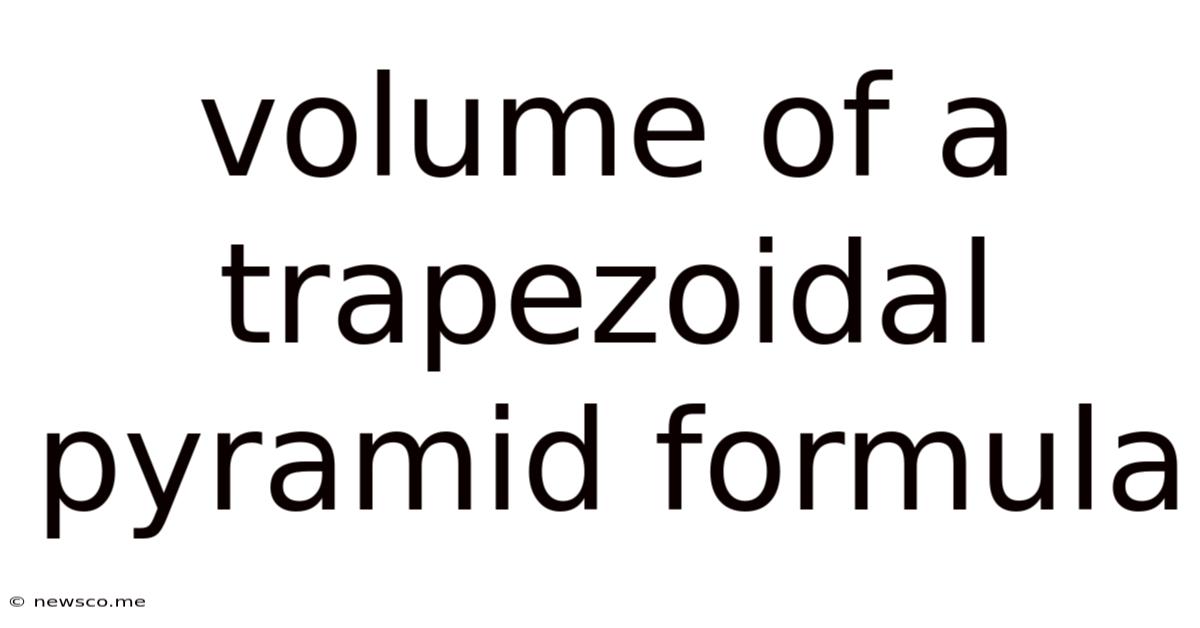Volume Of A Trapezoidal Pyramid Formula
News Co
May 07, 2025 · 4 min read

Table of Contents
Decoding the Volume of a Trapezoidal Pyramid: A Comprehensive Guide
The trapezoidal pyramid, a three-dimensional shape with a trapezoid as its base and triangular lateral faces meeting at an apex, presents a unique challenge in volume calculation. Unlike simpler pyramids, its irregular base necessitates a more nuanced approach. This comprehensive guide delves into the intricacies of calculating the volume of a trapezoidal pyramid, exploring the underlying formula, its derivation, practical applications, and troubleshooting common errors. We’ll also examine related concepts and provide illustrative examples to solidify your understanding.
Understanding the Trapezoidal Pyramid
Before diving into the formula, let's establish a clear understanding of the trapezoidal pyramid's components. It's defined by:
- Trapezoidal Base: A quadrilateral with one pair of parallel sides (bases) and another pair of non-parallel sides. These parallel sides are denoted as b1 and b2.
- Height of the Trapezoid (h): The perpendicular distance between the parallel sides of the trapezoid.
- Height of the Pyramid (H): The perpendicular distance from the apex to the plane of the trapezoidal base.
Deriving the Volume Formula
The volume of any pyramid is fundamentally given by the formula:
Volume = (1/3) * Base Area * Height
For a trapezoidal pyramid, the challenge lies in calculating the area of the trapezoidal base. The area of a trapezoid is given by:
Area of Trapezoid = (1/2) * (b1 + b2) * h
Substituting this into the general pyramid volume formula, we obtain the specific formula for the volume of a trapezoidal pyramid:
Volume of Trapezoidal Pyramid = (1/3) * [(1/2) * (b1 + b2) * h] * H
This can be simplified to:
Volume of Trapezoidal Pyramid = (1/6) * (b1 + b2) * h * H
Where:
- b1 and b2 represent the lengths of the parallel sides of the trapezoidal base.
- h represents the height of the trapezoidal base.
- H represents the height of the pyramid.
Step-by-Step Calculation
Let's break down the calculation process with a step-by-step example:
Example: Consider a trapezoidal pyramid with the following dimensions:
- b1 = 5 cm
- b2 = 10 cm
- h (base height) = 4 cm
- H (pyramid height) = 8 cm
Steps:
-
Calculate the area of the trapezoidal base: Area = (1/2) * (5 cm + 10 cm) * 4 cm = 30 cm²
-
Calculate the volume of the trapezoidal pyramid: Volume = (1/3) * 30 cm² * 8 cm = 80 cm³
Therefore, the volume of the trapezoidal pyramid is 80 cubic centimeters. Using the simplified formula directly:
Volume = (1/6) * (5 cm + 10 cm) * 4 cm * 8 cm = 80 cm³
Practical Applications
Understanding the volume of a trapezoidal pyramid has various practical applications across diverse fields:
- Civil Engineering: Calculating the volume of earthworks, like embankments or excavations, often involves dealing with trapezoidal shapes.
- Architecture: Determining the volume of roof structures or certain building components might require calculating the volume of trapezoidal pyramids.
- Manufacturing: Designing and optimizing the packing of irregularly shaped products often involves understanding the volume calculations of various three-dimensional shapes, including trapezoidal pyramids.
- Geology: Estimating the volume of geological formations that approximate a trapezoidal pyramid shape.
Advanced Considerations and Variations
While the standard formula provides a robust framework, some advanced considerations may be necessary:
- Oblique Trapezoidal Pyramids: If the apex of the pyramid isn't directly above the centroid of the trapezoidal base (an oblique pyramid), the calculation becomes slightly more complex. The height (H) needs to be precisely defined as the perpendicular distance from the apex to the base plane.
- Irregular Trapezoidal Pyramids: For extremely irregular pyramids, numerical methods or computer-aided design (CAD) software may be needed for precise volume estimation.
- Units of Measurement: Always maintain consistent units of measurement throughout the calculation. Mixing centimeters and meters, for example, will lead to an incorrect result.
Common Errors and Troubleshooting
- Confusing Base Height and Pyramid Height: The most common mistake is confusing the height of the trapezoidal base (h) with the height of the pyramid (H). Ensure you correctly identify and use the appropriate values for both.
- Incorrect Trapezoid Area Calculation: Double-check the trapezoid area calculation. A common error is forgetting to divide by 2.
- Unit Inconsistency: As mentioned, always ensure consistent units throughout. Convert all measurements to the same unit before beginning the calculation.
- Rounding Errors: Avoid premature rounding. Round only the final answer to the desired level of precision.
Related Geometric Concepts
Understanding the volume of a trapezoidal pyramid builds upon several core geometric concepts:
- Pyramids: The trapezoidal pyramid is a specific type of pyramid. Understanding general pyramid volume calculations is fundamental.
- Trapezoids: A solid grasp of trapezoid area calculation is essential.
- Three-Dimensional Geometry: The concept builds upon spatial reasoning and the ability to visualize three-dimensional shapes.
Conclusion
Mastering the calculation of a trapezoidal pyramid's volume empowers you to solve diverse real-world problems across multiple disciplines. By understanding the formula's derivation, applying the steps methodically, and being mindful of potential errors, you can confidently tackle even the most complex geometric challenges. Remember to double-check your measurements and calculations to ensure accuracy. With practice, the process will become second nature, enabling you to confidently navigate this fascinating area of three-dimensional geometry. This detailed guide provides a robust foundation for accurately determining the volume of trapezoidal pyramids, equipping you with the knowledge to tackle practical applications with confidence.
Latest Posts
Related Post
Thank you for visiting our website which covers about Volume Of A Trapezoidal Pyramid Formula . We hope the information provided has been useful to you. Feel free to contact us if you have any questions or need further assistance. See you next time and don't miss to bookmark.